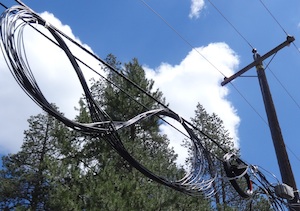
Time to untangle.
California is large enough and our economy is advanced enough to support independent telecommunications policy making, as the California Public Utilities Commission is beginning to do. It’s a start in the right direction, and more can be done…
-
In recent decisions regarding the California Advanced Services Fund, the CPUC has made useful and workable distinctions between middle and last mile broadband infrastructure, requiring open access on transparent terms to the former and non-discriminatory access to the latter. These principles should be universally extended to publicly owned telecommunications assets, such as conduit and rights of way, and to privately owned assets that were built or obtained with the assistance of public rents. Ownership of publicly subsidised or sanctioned infrastructure should not be a means to protect service providers from competition.
-
Current Californian policy regarding construction of and access to broadband infrastructure is based on antiquated distinctions between the types of services provided. In the past, technology determined service and vice versa: telephone networks were necessarily continental-scale, narrow-band voice systems run on pairs of copper wire, while wide band television service was delivered via coaxial cable and limited by physics and programming distribution rights to local markets. Public policy evolved – correctly at the time – to accommodate the unique characteristics of each. But those conditions no longer obtain. Regardless of heritage or current business model, all telecommunications companies should be subject to the same rules regarding access to civil infrastructure, including pole routes and conduit, access to telecommunications facilities such as middle mile fiber and last mile copper, and technical standards for building, maintaining and operating networks. Services should be similarly (and, I would argue, lightly) regulated according to the functionality delivered to end users, without regard to underlying technology.
-
In order to build broadband infrastructure in California, investors must navigate a patchwork of local, regional and statewide policies and largely autonomous regulatory authorities. Incumbents, large and small, use this jurisdictional incoherence to protect themselves from competition, often with the active cooperation of local decision makers. Small, disruptive and self-interested groups can use state laws, such as the California Environmental Quality Act, and byzantine local permit processes, to stall or completely kill broadband infrastructure upgrades. Private investment follows swift and certain decisions. To attract new sources of broadband investment, California must rationalise broadband infrastructure construction policy into a technically-focused, independently administered statewide regime, [much as the FCC regulates spectrum access and use]().
Control of political or policy-making processes, whether gained with lobbyists and cash today or woven with red tape and practice over the years, cannot determine who is allowed to build California’s future, if it is to be built at all.
